Astronomers have discovered a new object which shares a very similar orbit with Neptune. Part of a classification of objects called Trojans, 2001 QR322 is 230 km across and requires 166 years to orbit the Sun. Although clusters of Trojans have been found following Jupiter’s orbit, none have ever been found to share an orbit with any other giant planet; although, they’ve been predicted for years.
Protoplanetary Disk Found Around a Star
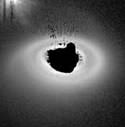
Image credit: Hubble
The new Advanced Camera for Surveys (ACS) on the Hubble Space Telescope has revealed a clear disk of dust around a young, 5 million year old star. Astronomers believe these disks are the birthplaces of planets. The star, called HD 141569A is part of a triple star system located 320 light-years away in the constellation of Libra.
NASA Hubble Space Telescope’s new Advanced Camera for Surveys (ACS) has given astronomers their clearest view yet of the dust disk around a young, 5-million-year-old star. Such disks are expected to be the birthplace of planets. The star, called HD 141569A, lies 320 light-years away in the constellation Libra and appears to be a member of a triple-star system.
The star HD 141569A was first identified as a candidate for a circumstellar disk in 1986, from observations done with the NASA/Netherlands/United Kingdom Infrared Astronomy Satellite (IRAS). An excess of infrared radiation associated with the star provides telltale evidence for the presence of a dust disk. Hubble’s Near Infrared Camera and Multi-Object Spectrometer photographed the disk in 1999 and revealed two concentric rings divided by a dark lane. This was interpreted as evidence of dynamical sculpting by one or more planets.
The ACS reveals that the disk’s structure is much more complex than previously thought. The disk is actually a tightly wound spiral structure. The outer regions of the disk reveal two diffuse spiral arms, one of which appears to be associated with the nearby double star system (HD 141569BC) seen at the upper left. The apparent connection between the disk and the double star suggest that an interaction with the double star may be responsible for the structures seen in the disk.
However, previous mid-IR images of the disk show that it is relatively clear of dust within approximately 2.8 billion miles of the star. This inner region may have been swept clear by one or more unseen planets.
These observations of the disk were obtained with the ACS’s High Resolution Camera (HRC) coronagraph. The photo on the left is a processed visible light image. In the photo on the right, the disk has been geometrically altered to simulate a face-on view, and false-color has been applied to enhance the disk structure. The black center marks regions where light from the star has been masked out. These images are the first results of a survey of disks around young main-sequence stars being conducted by the ACS science team.
Original Source: Hubble News Release
Hubble Uses Galactic Lens to Look Further
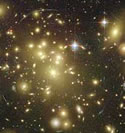
Image credit: Hubble
The Hubble Space Telescope has used a natural 2-million-light-year wide “zoom lens” to look further into space than it normally could. By peering directly through the centre of one of the most massive galactic clusters known, it was able to take advantage of a technique called gravitational lensing to see objects beyond the cluster. Detailed analysis of the image may help shed some light on the mystery of dark matter.
The Advanced Camera for Surveys aboard NASA’s Hubble Space Telescope has used a natural “zoom lens” in space to boost its view of the distant universe. Besides offering an unprecedented and dramatic new view of the cosmos, the results promise to shed light on galaxy evolution and dark matter in space.
Hubble peered straight through the center of one of the most massive galaxy clusters known, called Abell 1689. This required that Hubble gaze at the distant cluster, located 2.2 billion light-years away, for over 13 hours. The gravity of the cluster’s trillion stars ? plus dark matter ? acts as a 2-million-light-year-wide “lens” in space. This “gravitational lens” bends and magnifies the light of galaxies located far behind it.
The Advanced Camera’s IMAX movie-quality sharpness, combined with the behemoth lens, reveals remote galaxies previously beyond even Hubble’s reach. A few may be twice as faint as those photographed in the Hubble Deep Field, which previously pushed the telescope to its sensitivity limits. Though much more analysis is needed, Hubble astronomers speculate that some of the faintest objects in the picture are probably over 13 billion light-years away (redshift value 6).
In the image hundreds of galaxies many billions of light-years away are smeared by the gravitational bending of light into a spider-web tracing of blue and red arcs of light. Though gravitational lensing has been studied previously with Hubble and ground-based telescopes, this phenomenon has never been seen before in such detail. The ACS picture reveals 10 times more arcs than would be seen by a ground-based telescope. The ACS is 5 times more sensitive and provides pictures that are twice as sharp as the previous work-horse Hubble cameras. So it can see the very faintest arcs with greater clarity. The picture presents an immense jigsaw puzzle for Hubble astronomers to spend months untangling. Interspersed with the foreground cluster are thousands of galaxies, which are lensed images of the galaxies in the background universe.
Detailed analysis of the images promises to shed light on the mystery of dark matter. Dark matter is an invisible form of matter. It is the source of most of the gravity in the universe because it is much more abundant than the “normal matter” that makes up planets, stars and galaxies. The lensing allows astronomers to map the distribution of dark matter in galaxy clusters. This should offer new clues to the nature of dark matter. By studying the lensed distant galaxies, astronomers expect to better trace the history of star formation in the universe, over the past 13 billion years.
The picture is an exquisite demonstration of Albert Einstein’s prediction that gravity warps space and therefore distorts a beam of light, like a rippled shower curtain. Though Einstein realized this effect would happen in space, he thought it could never be observed from Earth. Though individual stars lens background light, the deflection was too small to ever be seen from Earth. When the laws of relativity were formulated in the early 20th century, scientists did not know that stars were organized into galaxies beyond our own Milky Way. Great clusters of galaxies are massive enough to warp space and deflect light in a way that is detectable from Earth. The Abell cluster is the ideal target because it is so massive. The more massive a cluster, the larger the effects of gravitational lensing.
Original Source: Hubble News Release
Gullies on Mars Not Formed by Water?
Gullies on Mars were discovered in 2001 that seemed to show evidence that liquid water had been on the surface of the planet very recently. But a theory from a University of Melbourne geologist examines the possibility that the gullies were carved by an avalanche of carbon dioxide changing directly from a solid to a gas. This theory has been met with skepticism from other Mars researchers, who are hoping that liquid water might someday be found on Mars, increasing the possibility of finding life.
An Australian geologist has identified what could be the first ever active flow of fluids through gullies on Mars.
University of Melbourne geologist, Dr Nick Hoffman, identified recent gully and channel development near the polar regions of Mars from images taken by the Mars Global Surveyor spacecraft. But contrary to the majority of scientific opinion which suggests that such features were carved by liquid water, Hoffman says the flow is most likely frozen carbon dioxide.
NASA is desperate to find signs of liquid water on Mars so they have a target for the next generation of Mars landers and rovers to go and search for life, but their search could prove fruitless if Hoffman’s analysis of the images is correct.
In the latest edition of the journal Astrobiology, Hoffman presents evidence for the flow events on Mars and demonstrates that there are substances other than water that can flow on Mars and that water is probably the least likely substance to do this. Hoffman says the channels he identified from the Surveyor images are more likely being carved by avalanches of carbon dioxide and associated debris.
“The consequences of this for life on Mars are shattering. If similar mechanisms are responsible for all the recent gullies on Mars then the near surface life NASA is so desperately searching for may not exist,” says Hoffman.
“Without liquid water there cannot be life and despite recent reports of more and more ice on the Red Planet, NASA has yet to find liquid water,” he says.
Many NASA scientists are doubtful about Hoffman’s observations, but at a meeting of the American Geophysical Union held last month, Hoffman says they struggled to find arguments against the evidence he presented.
The Mars Gullies were discovered in 2001. Hoffman’s analysis of the recent images shows that a patch of gullies near the South Pole shows signs of annual flow activity each Martian Spring.
“In itself the observation of active flows is a dramatic discovery since no movement has yet been seen on Mars, except for some dry dust avalanches. The gullies are thought to be the most promising candidates for liquid water flows on modern Mars and many NASA researchers are suggesting ways in which they might be formed by liquid water, but nobody has yet seen the gullies in action,” says Hoffman.
Hoffman suggests NASA researchers missed these most exciting events happening in the gullies as they have been focussed on looking for liquid water in late summer.
“In the Martian Spring, when carbon dioxide frost and snow at temperatures of minus130 degrees Centigrade still fill the valleys, flow events are occurring. The flows cut through the frost at temperatures that would turn battery acid into building stone,” he says.
“Nothing based on water can flow at these temperatures, so the culprit must be defrosting carbon dioxide.
“But carbon dioxide doesn’t melt on Mars; it boils directly from the solid (a process called ‘sublimation’). Instead of a trickle or gush of liquid pouring down the gully, the flow appears to be a flurry of boiling dry ice avalanching down the gully. The boiling dry ice acts like a amarda of miniature hovercraft carrying a shower of sand, dust, and tumbling rocks down the slope, carving out the gullies as it goes.
Original Source: University of Melbourne News Release
Ariane Inquiry Board Submits its Findings
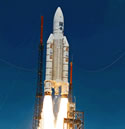
Image credit: Arianespace
According to a commission of inquiry, the failure of the new Ariane 5-ESCA rocket appears to have been caused by a leakage in the cooling system. Approximately 456 seconds into the vehicle’s flight, it veered off course and had to be destroyed. With it went two satellites worth 600 million euros. The results of this inquiry clear the way for the launch of the Rosetta comet mission in the next few weeks.
The Inquiry Board appointed to investigate the failure of Flight 157 submitted its report to Arianespace on January 6, 2003. The board was named last December 13 to establish the causes of the anomaly during the flight of an Ariane 5 ECA on the night of December 11-12, 2002.
As requested, the board established the most probable cause for the mission failure, examined possible consequences for the baseline Ariane 5 launcher version, and recommended actions to correct the problems that occurred during the Ariane 5 ECA flight
Arianespace has accepted all the recommendations of the board, and will prepare an action plan by January 20 to enable a return to service of the Ariane 5 ECA during the second half of 2003.
The Inquiry Board
Cause of the failure
A complete analysis of all measurements recorded during Flight 157 was carried out, along with a review of documentation concerning production, quality and technical records for the Ariane 5 ECA, as well as for all Ariane 5 flights to date. Also reviewed by the board was the work of production and development teams in Europe.
The board’s findings confirm that all preparatory and countdown operations for Flight 157 went normally, as did the flight sequence until the separation of the solid boosters.
The report of the Inquiry Board did identify the occurrence of a leak in the of the Vulcain 2 nozzle’s cooling circuit during this first flight phase, followed by a critical overheating of the nozzle – which led to a loss of its integrity.
This resulted in a major imbalance in the thrust of the Vulcain 2 engine due to the nozzle’s deterioration, leading to a loss of control over the launcher’s trajectory.
# In conclusion, the most probable cause of the failure of Flight 157 was the simultaneous occurrence of two aggravating factors: The degraded thermal condition of the nozzle due to fissures in the cooling tubes, and
# Non-exhaustive definition of the loads to which the Vulcain 2 engine is subjected during flight
The board also noted that it would be difficult to simulate these additional loads during ground tests.
Consequences for the Ariane 5 Baseline
The designs of nozzles on the Ariane 5 Baseline’s Vulcain 1 engine and the Vulcain 2 engine for Ariane 5 ECA differ in two main ways:
# The shape of the cooling tubes, which form the structure of the nozzle, and
# The technology of the nozzle’s stiffeners.
After reviewing operating data from the Vulcain 1 engine’s 12 successful flights, the Inquiry Board did not identify any weaknesses concerning the functioning and resistance of its nozzle. The Inquiry Board nevertheless requested an exhaustive examination of the behavior of the Vulcain 1 engine nozzle, including precise modeling to demonstrate the component’s correct behavior during the flight. These verifications currently are in progress.
Consequences for Ariane 5 ECA
The Inquiry Board requested that the following actions be taken:
# Modification of the Vulcain 2 nozzle, taking into account experience acquired with the Vulcain 1 engine nozzle,
# Assessment of possibilities for simulation during ground tests of loads observed during actual flight on the Vulcain 2 engine, and
# Enhancing of the quality of flight equipment.
Consequences for Rosetta launch
In view of the specific factors involved in this flight, Arianespace has decided to create a Review Board to make a decision on Tuesday, January 14 regarding the mission’s launch date.
Upcoming Arianespace launches
# February 11: Ariane 4
# Second half of February: an Ariane 5 Baseline launcher version
Original Source: Arianespace News Release
Furthest Extrasolar Planet Discovered
Astronomers from the Harvard-Smithsonian Center for Astrophysics announced today that they have discovered a Jupiter-class planet orbiting a star 5,000 light years away – the most distant ever found. The planet, called Ogle-TR-56b is important because it’s only the second planet ever discovered that passes directly in front of its star, dimming it slightly. More than 100 extrasolar planets have now been discovered. (BBC Article)
Starving Black Hole at the Centre of our Galaxy
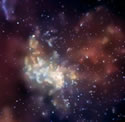
Image credit: Chandra
Using the Chandra X-Ray Observatory, astronomers have created one of the most vivid images of Sagittarius A, an area at the centre of our Milky Way galaxy thought to contain a supermassive black hole. The exposure was made over a period of two weeks, and during that time, the region flared up several times; presumably when additional material reached the black hole’s event horizon.
This Chandra image of the supermassive black hole at our Galaxy’s center, a.k.a. Sagittarius A* or Sgr A*, was made from the longest X-ray exposure of that region to date. In addition to Sgr A* more than two thousand other X-ray sources were detected in the region, making this one of the richest fields ever observed.
During the two-week observation period, Sgr A* flared up in X-ray intensity half a dozen or more times. The cause of these outbursts is not understood, but the rapidity with which they rise and fall indicates that they are occurring near the event horizon, or point of no return, around the black hole. Even during the flares the intensity of the X-ray emission from the vicinity of the black hole is relatively weak. This suggests that Sgr A*, weighing in at 3 million times the mass of the Sun, is a starved black hole, possibly because explosive events in the past have cleared much of the gas from around it.
Evidence for such explosions was revealed in the image – huge lobes of 20 million-degree Centigrade gas (the red loops in the image at approximately the 2 o’clock and 7 o’clock positions) that extend over dozens of light years on either side of the black hole. They indicate that enormous explosions occurred several times over the last ten thousand years.
Further analysis of the Sgr A* image is expected to give astronomers a much better understanding of how the supermassive black hole in the center of our galaxy grows and how it interacts with its environment. This knowledge will also help to understand the origin and evolution of even larger supermassive black holes found in the centers of other galaxies.
Original Source: Chandra News Release
Distant and Fast Moving Object Discovered
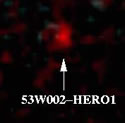
Image credit: NASA
A team of astronomers from the California Institute of Technology in Pasadena presented images today of a rare Hyper Extremely Red Object (Hero). This dim object, located near a galaxy 10 billion light years away is traveling away from us at almost the speed of light. In fact, it’s so far, and moving so fast, it has gone way past being red-shifted – it’s only visible in infrared light.
Heroes are usually confined to comic books and movies, but as the saying goes, we all need one. So astronomers have turned to the deep, dark cosmos to find their heroic figure — the “Hyper Extremely Red Object,” or “Hero.”
At the American Astronomical Society winter meeting in Seattle today, an astronomer from the California Institute of Technology in Pasadena reports the discovery of a Hero near the radio galaxy 53W002, more than 10 billion light years away. This marks the first time a Hero has been found near a radio galaxy, suggesting that radio galaxies — which are optically dim but have strong radio emissions — may provide a guidepost for scouting out other Hero objects.
“Hero objects are intriguing. Like comic book heroes, they travel really fast — almost at the speed of light. They are virtually invisible to our eyes and they are very mysterious. Most importantly, this type of Hero may hold a key for understanding how the first galaxies formed and evolved in the universe,” said Dr. Myungshin Im, a staff research scientist at the Space Infrared Telescope Facility Science Center, located at Caltech.
So far, the astronomical version of a hero has taken on the unassuming guise of a small, glowing, red patch in deep space. More advanced infrared telescopes like NASA’s Space Infrared Telescope Facility, managed by the Jet Propulsion Laboratory, Pasadena, Calif., and launching in spring 2003, may, among other things, lift this red veil and reveal these remote objects for what they really are — quite possibly the universe’s earliest stars and galaxies.
Due to expansion of the universe after the Big Bang, a distant object in the universe races away from us so fast that any visible light from it “redshifts” — in other words, a light source becomes redder when it recedes from observers on Earth, and, conversely, bluer when it approaches. So when a visible light source moves away from us at nearly the speed of light, it often appears in infrared wavelengths. Big Bang theory also implies that the farther away an object is, the faster it moves away from us.
53W002_HERO1, the designation for the newly found Hero, is so far away and moves so fast it appears as a faint infrared source. In fact, it took two powerful telescopes equipped with infrared cameras to spot it in the deep sky. Im discovered 53W002_HERO1 from images taken by the near-infrared camera and multi-object spectrometer on NASA’s Hubble Space Telescope and the cooled infrared spectrograph and camera attached to the Subaru 8-meter (26-feet) telescope atop Mauna Kea in Hawaii. Dr. Toru Yamada and collaborators at the National Astronomical Observatory of Japan provided Im with the Subaru data.
The more distant a cosmic object is, the further in the past we see it. But for Im and colleagues to glean information about the early universe from 53W002_HERO1, they first need to determine its intrinsic color — that is, how would this astronomical hero appear to a human observer nearby?
It could be red, indicating either dust-obscured galaxies cocooning intense star formation, or older galaxies filled with an overabundance of elderly, reddish stars, both of which would lie about 10 billion light-years away. If the former condition exists, astronomers will appreciate the degree to which dust hid star formation during that epoch. However, if the latter holds then scientists can trace back to a time when a significant population of stars were born.
Another possibility is that a Hero might really be blue — a very young galaxy populated with fresh, super-hot blue stars at a distant 13 to 14 billion light years. In this instance, we may be witnessing the formation of the universe’s very first galaxies.
To determine whether 53W002_HERO1 is intrinsically red or blue, Im and his colleagues will peer at these mysterious objects in the redder part of infrared, a feat that requires a view from above Earth’s infrared-absorbing atmosphere. This will be accomplished with the Space Infrared Telescope Facility.
Original Source: NASA/JPL News Release
Ring of Stars Found Around our Milky Way
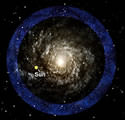
Image credit: Rensselaer Polytechnic Institute
Astronomers announced today that they have discovered a giant ring of stars circling the Milky Way. They believe this ring could contain as many as 500 million stars, and was formed when our galaxy collided with a smaller, dwarf galaxy several billion years ago. Other galaxies have been seen with a halo of stars, including Andromeda.
A previously unseen band of stars beyond the edge of the Milky Way galaxy has been discovered by a team of scientists from Rensselaer Polytechnic Institute, Fermi National Accelerator Laboratory, and the Sloan Digital Sky Survey (SDSS). The discovery could help to explain how the galaxy was assembled 10 billion years ago.
This ring around the Milky Way galaxy discovered by the Sloan Digital Sky Survey may be what’s left of a collision between our galaxy and a smaller, dwarf galaxy that occurred billions of years ago. It’s an indication that at least part of our galaxy was formed by many smaller or dwarf galaxies mixing together, explained investigators Heidi Jo Newberg of Rensselaer Polytechnic Institute and Brian Yanny of the Fermi National Accelerator Laboratory’s Experimental Astrophysics Group. For illustration purposes, the sun is approximately 30,000 light years from the center of the galaxy. Traveling from Earth at the speed of light, it would take 40,000 light years to reach the newly-discovered ring of stars.
Hidden from view behind stars and gas on the same visual plane as the Milky Way, this ring of stars is approximately 120,000 light years in diameter, says Heidi Newberg, associate professor of physics and astronomy at Rensselaer and a co-lead investigator on the project. Traveling from Earth at the speed of light, it would take 40,000 light years to reach the ring.
“These stars may be what’s left of a collision between our galaxy and a smaller, dwarf galaxy that occurred billions of years ago,” says Newberg. “It’s an indication that at least part of our galaxy was formed by many smaller or dwarf galaxies mixing together.”
The ring of stars is probably the largest of a series of similar structures being found around the galaxy. Investigators believe that as smaller galaxies are pulled apart, the remnants dissolve into streams of stars around larger galaxies. Gravity, primarily from unseen dark matter, holds the ring in a nearly circular orbit around the Milky Way.
“What’s new is the position of the star belt on the outskirts of the Milky Way, an ideal position to study the distribution and amount of dark and light mass within the band,” said Brian Yanny, a scientist at Fermilab’s Experimental Astrophysics Group and a co-lead investigator on the project.
Newberg and Yanny presented their findings today at the American Astronomical Society meeting in Seattle, Washington.
Evidence of this new unexpected band of stars hidden by the Milky Way comes from multi-color photo imagery of hundreds of square degrees of sky and hundreds of spectroscopic exposures from the Sloan Digital Sky Survey, the largest international collaborative astronomical survey ever undertaken.
For four years Newberg, Yanny, and a collaboration of SDSS scientists have been examining the distribution of stars in the Milky Way. At the outer edge of the galaxy in the direction of the constellation Monoceros (the Unicorn) they found tens of thousands of unexpected stars that altered then-standard galactic models.
Three-dimensional mapping from the SDSS revealed the excess stars were actually parts of a separate structure outside the Milky Way.
“The large area covered by the Sloan Survey and the accuracy of the multi-colored observations has allowed us to revisit some classic questions, questions from 50 to 100 years ago,” Yanny said. “What does our Milky Way look like as a whole? How did it form? Did it form in one ‘whoosh,’ or was it built up slowly via mergers of collapsing dwarf galaxies? And how does the mysterious dark (invisible) matter affect the distribution of stars?”
Original Source: SDSS News Release
Titan II Lofts Coriolis Satellite
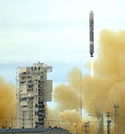
Image credit: USAF
After five scrubbed launch attempts, a Titan II rocket finally roared up from Vandenberg Air Force Base on Monday, lifting a Coriolis spacecraft into orbit. The $224 million satellite was funded by the US Air Force and Navy to study wind patterns in the Earth’s oceans. The Titan II rocket that launched the satellite used to be tipped with a nuclear warhead, but it was repurposed as part of the strategic arms reductions.
The 30th Space Wing, the 576th Flight Test Squadron here and a task force from the 91st Space Wing, Minot AFB, N.D., launched an unarmed Minuteman III intercontinental ballistic missile at 4:31 a.m. today from North Vandenberg as part of a flight test for Air Force Space Command’s Force Development Evaluation Program.
Launch activities were directed by Capt. Rob Light, 576th FLTS. Lt. Col. James Cardinal, 91st Maintenance Operations Squadron commander, was the task force commander. Lt. Col. Anthony Blaylock, 576th FLTS commander, was mission director for this launch. Col. Wayne Louis, 30th Space Wing vice commander, was the spacelift commander, or final go/no-go authority for the launch.
Original Source: Air Force News Release
